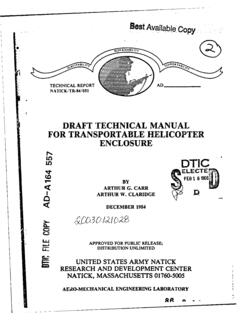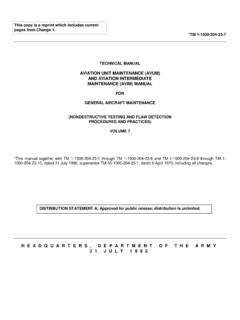Transcription of [ 0 DEPOT MAINTENANCE W HANDBOOK OrT I -i
1 [ 0 depot maintenance . { 0W HANDBOOK . VI. 0. OrT I -i 4m E__3'ELECTE. _. Imact Of Repair On Ptential Longevity I. We~bar-in Stable Meat Life Ieat-out I I. If IOverhaul minor 3mir L "- ""- 'j Discrepancy Tim. ARMY aviation SYSTEMS COMMAND. I: LL . -- k ..- r-A. UNCLASSIFIED. SECURITY CLASSIFICATION OF THIS PAGE. REPORT DOCUMENTATION PAGE OA N 067018. 1a. REPORT SECURITY CLASSIFICATION l b. RESTRICTIVE MARKINGS. Unclassified 2a. SECURITY CLASSIFICATION AUTHORTY 3. DISTRIBUTION/AVAILABILITY OF REPORT. Approved for public release;. 2b. DECLASSIFICATION/DOWNGRADING SCHEDULE distribution is unlimited 4. PERFORMING ORGANIZATION REPORT NUMBER(S) S. MONITORING ORGANIZATION REPORT NUMBER(S). tTIAC-85-1. 6a. NAME OF PERFORMING ORGANIZATION 6b. OFFICE SYMBOL 7a. NAME OF MONITORING ORGANIZATION. NTIAC (fa a e S Army aviation Systems Command Southwest Research Institute I. 6c. ADDRESS (City, State, and ZIP Code) 7b.)]}
2 ADDRESS (City, State, and ZIP Code). Drawer 28510 DEPOT Engineering & RCM Support Office San Antonio, "TZ 78284 CCAD. Corpus Christi, TX 78419-6195. 8a. NAME OF FUNDING/SPONSORING 8b. OFFICE SYMBOL 9. PROCUREMENT INSTRUMENT IDENTIFICATION NUMBER. ORGANIZATION (If applicable). Defense Logistics Agency DTIC-DF DLA900-84-C-0910, CLIN 0001AJ. 8c. ADDRESS (City, State, and ZIP Code) 10. SOURCE OF FUNDING NUMBERS. PROGRAM PROJECT TASK WORK UNIT. Cameron Station Alexandria, VA 22304 ELEMENT NO. NO. NO. ACCESSION NO. 11. TITLE (Include Security Classfication). DEPOT MAINTENANCE HANDBOOK 12. PERSONAL AUTHOR(S). Brauer, D. Henry, Matzkanin 13a. TYPE OF REPORT 13b. TIME COVERED 14. DATE OF REPORT (Year, Month, Day) IS. PAGE COUNT. HANDBOOK FROM 6/27/84 TO6/30/85 June 30, 1985 67. 16. SUPPLEMENTARY NOTATION. Prepared as a Special Task for the Nondestructive Testing Information Analysis Center.
3 17. COSATI CODES 18. SUBJECT TERMS (Continue on reverse if necessary and identify by block number). FIELD GROUP SUB-GROUP k' Reliability * Aircraft Inspection Maintainability Nondestructive Testing '. I I DEPOT MAINTENANCE ABSTRACT (Continue on reverse if necessary and identify by block number). The DEPOT MAINTENANCE Handook was developed to help ensure the continued efficient and effective manner in which Z intenance is performed at the Corpus Christi Army DEPOT . This HANDBOOK is directed to engieers, on-line MAINTENANCE personnel, and others who are involved in the planning and erformance of MAINTENANCE at the DEPOT level. It provides reference information for eng neers so that they may effectively address AVSCOM Engineering Directives (AEDs) and AVSCOM ngineering Calls (AECs). It provides general information on the overall DEPOT repair pro ess and guidelines for repair action of the major failure modes encountered at the DEPOT .
4 /. 20. DISTRIBUTION/AVAILABILITY OF ABSTRACT 21. ABSTRACT SECURITY CLASSIFICATION. 0 SAME AS RPT. 0 DTIC USERS. 22a. NAME OF RESPONSIBLE INDIVIDUAL 22b. TELEPHONE (Include Area Code) 22c. OFFICE SYMBOL. O0 Form 1473, JUN 86 Previous editions are obsolete SECURITY CLASSIFICATION OF THIS PAGE. UNCLASSIFTED. NTIAC-W5- DEPOT MAINTENANCE . HANDBOOK . 14. DIT2Yr ENGWFEPG. AM ND SUPOT. Prepared as a Special Task under the auspices of the Nondestructive Testing Inforrmation Analysis Center for f ARMY aviation SYSTEMS COMMAND. K 89 APRIL 1985. 89 7 11 042. SECOND PRINTING. 1981. F1. FOREWORD. This HANDBOOK was developed to help ensure the continued efficient and effective manner in which MAINTENANCE is performed at the Corpus Christi Army DEPOT (CCAD). It is specifically designed for the Army aviation Systems Command (AVSCOM). for reference purposes only and does not in any way supercede or supplement any official Army document.
5 The HANDBOOK is directed to engineers, on-line MAINTENANCE personnel, and others who are involved in the planning and performance of MAINTENANCE at the DEPOT level. It provides reference information for engineers so that they may effectively address AVSCOM Engineering Directives (AEDs) and AVSCOM Engineering Calls (AECs). It provides general information on the overall DEPOT repair process and guidelines for repair action of the major failure modes encountered at the DEPOT . This HANDBOOK was prepared by Reliability Technology Associates (RTA) as a Special Task under the auspices of the Nondestructive Testing Information Analysis Center (NTIAC) at Southwest Research Institute (SwRI) under Contract No. DLA900- 84-C-0910, CLIN 0001A. At RTA, Mr. Douglas C. Brauer compiled and organized the technical material and developed the HANDBOOK under the overall technical direction of Dr.
6 Daniel Henry. Final editorial preparation and publication was performed by NTIAC under the direction of Dr. George A. Matzkanin and Technical Publication Specialist, Mr. Don Moore. On the part of the AVSCOM, the project was under the technical management of Mr. Lewis Neri, Chief, DEPOT Engineering and RCM Support Office. Mr. Robert Ladner, Chief of Power Train/Power Plant Branch, guided the development of the HANDBOOK and provided the necessary Army documents and other information used as input. 0. The proponent of this publication is HQ, AVSCOM. Users are invited to send 0. comments to the- DEPOT Engineering and RCM Support Office, Attn: AMSAV-MR, Corpus Christi, TX 78419-6195. Revision and updating of the HANDBOOK are envisioned at appropriate intervals. ad*$. aM/or FDist ail speo ial (M5P ECTEO a0). _____,.L. _ .___. Xii TABLE OF CONTENTS. PAGE. ii INTRODUCTION .. 1. DEPOT MAINTENANCE PROCESS.
7 5. DEPOT LEVEL REPAIR 19. 0 19. e* 21. *Skin Damage .. 26. 9 Fastener 27. e 29. 0 30. * Wiring Damage .. 31. APPENDIX A - DEFINITIONS .. A-1. APPENDIX B - DESCRIPTIONS FOR VARIOUS GEAR AND SPLINE. DAMAGE .. B-i APPENDIX C - DESCRIPTIONS FOR VARIOUS BEARING DAMAGE.. I .. C -1.. APPENDIX D - NONDESTRUCTIVE INSPECTION PRACTICES .. D-I. APPENDIX E - UNIT CONVERSION E-I. APPENDIX F - TORQUE VALUES AND F-I.. V. Il 1 INTRODUCTION. -- This HANDBOOK is designed to serve as a reference guide in accomplishing DEPOT I MAINTENANCE repair tasks. modes encountered at the It describes the DEPOT repair process and the major failure DEPOT . It provides general guidelines for the repair of the major failure modes in order to effectively address AVSCOM Engineering Directives I (AEDs) and AVSCOM Engineering Calls (AECs). Army aircraft are maintained within a three-level MAINTENANCE concept in which DEPOT MAINTENANCE is the final level (see Figure 1-1).
8 The first level is aviation unit MAINTENANCE (AVUM), consisting primarily of preventive MAINTENANCE and minor repair/replacement functions. The second level is aviation intermediate MAINTENANCE (AVIM), consisting primarily of MAINTENANCE tasks exceeding AVUM capabilities (for example, special aircraft inspections and repair of specified components). The third level is DEPOT MAINTENANCE , consisting of MAINTENANCE tasks exceeding AVIM and AVUM capabilities. DEPOT MAINTENANCE is carried out in accordance with the DEPOT MAINTENANCE Work Requirement (DMWR). The DMWR is a document which establishes require- ments for disassembly, cleaning, inspection, repair, reconditioning, rehabilitation, modification, reassembly, servicing, testing, and packaging/preservation of aircraft, engines, aircraft components, and related ground support equipment. Op'etional Unit -Aviationt Unit Plaint A'i;q ~ r ivi t aeitet Preventive mtaitenance Meinttenance Bepair/Rteplacewnt All AVUH Tak Aircraft Sygtel Alis-not L.
9 I-odu*e Trouble Shooting Minn! IRgi- I ce~at Diagnosis a Adjustw t/Calibration . mitenance zCmIptcc F i 1-p1ctions airtenance - Weight -preflight, Daily, Periodic. Special balance, AOp, Intorlwdiat., special & Direct Exchange (01) Program 9 Direct Exchange (01) Prosma With AVV4. i" With AVIN. ))ProtrlmmdDepot Maintensoc!lllill "-" 6On-Condition Mtaintence /. - - Airfram Coalition ,,s- gval~m e (ACS). ard Tim Maintonsw:e Ra I Level Three MAINTENANCE DEPOT I. MiNnorRepair/Overhaul/Rabuilld - o4di ficstions Crash/battle Dowage Repair i Figure 1-1 Army MAINTENANCE Levels To determine the specific MAINTENANCE tasks to be performed, AVSCOM applies Reliability-Centered MAINTENANCE (RCM) concepts to aircraft and their dynamic components. RCM is a relatively new concept for developing optimum MAINTENANCE requirements and ultimately Integrated Logistic Support (ILS) data. RCM is based on the premise that more efficient and cost-effective life-time MAINTENANCE and logistic support programs can be developed using a well disciplined decision logic which focuses on the consequences of failure.
10 A computer-aided decision logic question sequence is applied to those parts that are MAINTENANCE and structurally significant in a particular end item, , engine, transmission, rotor system, control system, airframe, etc. Each significant component failure mode is evaluated to identify MAINTENANCE tasks, specifically those that can be performed at the DEPOT in accordance with the general guidelines given in this HANDBOOK . The logic process forces MAINTENANCE tasks to be classified into three areas: (1) Hard Time MAINTENANCE for those failure modes that require scheduled MAINTENANCE at predetermined fixed intervals of age or usage; (2) On-Condition MAINTENANCE (OCM) for those failure modes that require scheduled inspections or tests designed to measure deterioration of an item so that, based on the deterioration of the item, either corrective MAINTENANCE can be performed or the item can remain in service.



















